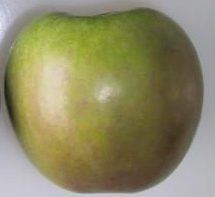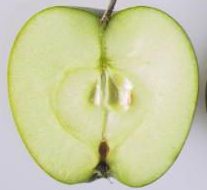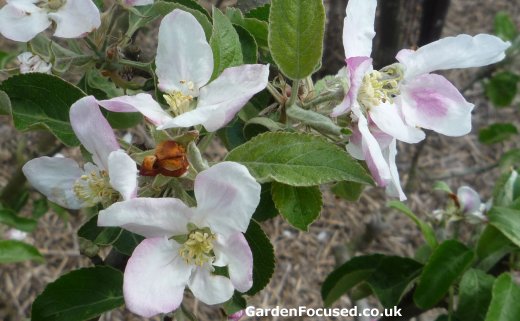PARENTAGE
No-one knows the parentage because this was a seedling which was found quite by chance. What is reasonably certain is that one of the parents was a French crab apple.
APPEARANCE AND TASTE OF GRANNY SMITH APPLES
The defining external look of a Granny Smith apple is a shiny, green skin. They produce round fruits which are of average to larger than average size. The fruits taste slightly acidic and develop their best flavour when grown in warmer parts of the UK and left to fully ripen on the tree.
The flesh is white with a hint of green, very crisp and firm. The skin is slightly thicker than normal. This variety stores extremely well, three months at the very least and up to six months in ideal conditions.

When the apples are cut for cooking or for use in a salad the flesh remains white far longer compared to most other apples. The surface will start to turn brown eventually of course but it does retain the white colour well for most purposes. For cooking purposes the apples tend to retain their shape rather than turning to a puree.
GROWING GRANNY SMITH APPLES IN THE UK
One key feature of this variety is that it needs a long season to develop the apples fully and it also needs a reasonable amount of warmth and sunlight. For this reason it is best grown in warmer parts of the UK. When grown in cool areas the fruit takes on a reddish hue and is generally considered to be too acidic for eating.
The only specific rules for planting a Granny Smith apple tree is to choose a position in full sun and if possible protected from strong winds. Other than that, follow our basic rules planting an apple tree. The trees are average as far vigour and height are concerned. We would suggest buying a Granny Smith on an M26 rootstock for a small to average sized garden. If your soil is poor consider an MM106 rootstock.

Flowering and fruiting times for a Granny Smith are specifically stated near the end of this article. The good news is that this variety is fully self-fertile and will produce a very good crop of apples even when grown on its own. It is in pollination group three which means it will benefit even further as far as pollination is concerned from neighbouring apple trees in groups 2, 3 and 4. It is also a very good pollinator of many other apple trees.

![]()
PESTS AND DISEASES OF GRANNY SMITH APPLE TREE
Granny Smith is just slightly below average as far as resistance to pests and diseases is concerned. By far the most common problem is powdery mildew. This affects young leaf shoots at first and appears as a white / light grey powder like coating. If left untreated it will spread to older leaves and the fruit. See the picture below for an example of how it looks on young shoots.

Repeated attacks of this fungus can weaken apple trees considerably reducing the crop of apples. The primary cause is an uneven supply of water and a crowded centre to the tree preventing air circulation. Mulching around the base of the tree especially at the edges of the canopy will preserve water and help ensure a constant an even supply. Click here for our page dedicated to identifying and preventing Powdery Mildew.
Other problems which are common with Granny Smith apple trees are scab and woolly aphid.
PRUNING A GRANNY SMITH APPLE TREE
Granny Smith is a partial tip bearing apple tree and should be pruned infrequently. See here for more advice on pruning partial tip bearing apple trees.
SUMMARY OF GRANNY SMITH APPLE TREES
USE: Eating and cooking
SKIN COLOUR / TEXTURE: Green, lightly tougher than normal
FLESH COLOUR: White
TASTE AND TEXTURE: Slightly acidic, full flavoured
FRUIT SIZE: Average to slightly larger
STORAGE: One of the very best, six months is possible
SUITABILITY FOR CORDON / ESPALIER GROWTH: No (partial tip bearer)
TREE SIZE: Average
REGULARITY OF CROPPING: Very reliable cropper
POLLINATION: Self-fertile. Pollination Group 3 (see here for suitable partners)
AWARDS: None
SPECIAL FEATURES: This is a partial tip bearing apple tree and should be pruned infrequently. See here for more advice on pruning partial tip bearing apple trees. Exceptionally long storage life.
FLOWERING AND HARVEST TIMES:
The average flowering time (optimum time for pollination) and date when fruits are ripe for harvest in the UK for the Granny Smith apple tree are set out below. If you have set your home town we can give you a more accurate estimate, if you have not set your home town (do it now by clicking here) the dates below will be the average for the UK.
Your town has not been set, the average main flowering time for Granny Smith
in the UK is the second week of May. Fruit will be ready for harvesting in the last week of October.
Click here if you want to set the dates to your home town.
Flowering and fruit picking dates vary according to the weather in any particular growing season so the above dates may well change slightly from one year to the next. The flowering date above is when the apple tree produces the maximum number of blossoms, it will also produce blossom, although less, a week or two either side of the date given.
BUYING GRANNY SMITH APPLE TREES
Granny Smith trees are available to buy from garden centres, plant nurseries and via websites in the UK.
In common with most other apple trees buying online from a garden centre looks to be the most expensive option although picking up a tree yourself from your local garden centre will give better prices.
Wait until November onwards and bare-rooted trees will be in stock at much cheaper prices compared to pot grown ones.
Remember that all apple trees need a stake to support them for the first couple of years and some require staking for life. So if you haven’t got a stake and a tie for your new tree then buy one when you order the tree for convenience.
COMMON POLLINATION PARTNERS FOR GRANNY SMITH
Granny Smith is in pollination group 3. It is self-fertile but in poor years it may produce more fruit if it has a pollination partner nearby. Suitable pollination varieties include the following:
- Alkmene – pollination group 2, self-sterile, eater
- Arthur Turner – pollination group 3, self-sterile, cooker
- Beauty of Bath – pollination group 2, self-sterile, eater
- Bountiful – pollination group 3, self-sterile, cooker
- Braeburn – pollination group 4, self-fertile, eater
- Charles Ross – pollination group 3, partially self-fertile, cooker and eater
- Court of Wick – pollination group 3, self-sterile, eater and cooker
- Devonshire Quarrenden – pollination group 2, partially self-fertile, cooker
- Discovery – pollination group 3, self-sterile, eating and cider
- Dumelows Seedling – pollination group 4, self-sterile, cooker
- Egremont Russet – pollination group 2, partially self-fertile, eater and cooker
- Ellison’s Orange – pollination group 4, partially self-fertile, eater
- Fiesta – pollination group 3, partially self-fertile, eater
- Gala – pollination group 4, self-fertile, eater
- Golden Delicious – pollination group 4, partially self-fertile, eater and cooker
- Greensleeves – pollination group 2, self-fertile, eater, cooker, juice
- Grenadier – pollination group 3, partially self-fertile, cooker
- Honeycrisp – pollination group 4, self-sterile, eater
- Howgate Wonder – pollination group 3, partially self-fertile, cooker and eater
- Idared – pollination group 2, self-sterile, eater
- James Grieve – pollination group 3, partially self-fertile, cooker and eater
- Katy – pollination group 3, self-sterile, eater
- Kidds Orange Red – pollination group 3, self-sterile, eater
- King of The Pippins – pollination group 4, partially self-fertile, eater and cooker
- Laxtons Superb – pollination group 4, partially self-fertile, eater
- Lord Derby – pollination group 4, self-sterile, cooker
- Lord Lambourne – pollination group 2, self-fertile, eater and cooker
- Newton Wonder – pollination group 4, partially self-fertile, cooker
- Peasgoods Nonsuch – pollination group 3, partially self-fertile, cooker
- Rajka – pollination group 4, self-sterile, eater
- Reverend W Wilks – pollination group 2, self-fertile, cooker
- Scrumptious – pollination group 3, self-fertile, eater
- Sops in Wine – pollination group 3, self-sterile, juicer
- Spartan – pollination group 3, self-fertile, eater
- Sunset – pollination group 3, self-fertile, eater
- Tydemans Late Orange – pollination group 4, self-sterile, eater
- Winston – pollination group 4, self-fertile, eater
- Worcester Pearmain – pollination group 3, partially self-fertile, eater
The full list of apple tree varieties which we have reviewed is listed below. Select any one of them and then click the “More Information” button to be taken to the in depth review:
Rootstocks and Size
Guide to Planting
Care Plan
Pruning Apple Trees
Harvest and Storage
Pests and Disease
Pollination Groups
GRANNY SMITH APPLE TREE
All credit to the Australians for growing this astonishingly successful apple tree variety. First identified by, you’ve guessed it, Granny Smith, this variety dates back to 1868.
Even in its fully ripened stage it looks boring, plain green and that’s about it. The taste though is extremely good, storage life is phenomenal and it’s well known for producing a large crop on a very regular basis. It is also a true multi-purpose apple. Eat it raw, cook it or serve it in a salad, it’s excellent for all purposes, even for cider and juicing.